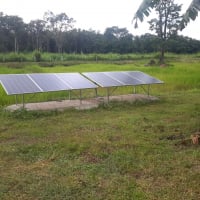Frequency Drives, friend or foe? Inverter Refrigerator use off grid

mcgivor
Solar Expert Posts: 3,854 ✭✭✭✭✭✭
The use of inverter appliances off grid is commonly viewed as a God send, lowering inrush current on start up, allowing smaller DC-AC inverters to be used and saving precious battery capacity due to better overall efficiency. On the surface this is true but are there hidden factors that are overlooked, such as the generation of harmonic distortion which possibly could damage equipment?
Whilst tending to battery maintenance the inverter was turned off, upon restoring power, the only AC load, the inverter refrigerator started, the DC-AC inverter had pulses of about 0.5 second duration, very low but audible buzz. This occurs only during the initial start, disappearing when up and running. Nothing unusual can be measured using a DVM (true RMS) on the AC side, voltage remains steady at 230V, no inrush current, 0.6A dropping to0.3A, on the DC side nothing unusual.
Thought it was a little strange and the thought of harmonics came to mind as in the past I have installed frequency drives, sometimes as many as 20 per site, the energy savings were noticeable but transformer overheating became an issue, all the drives were on the 600V side of the transformer the building side was 120/208V. Using a power quality analyzer it was determined that harmonics, 5th, 7th, 11th, 13th, 17th and 19th, were manifesting as heat in the transformer, since harmonics cannot pass through the transformer, the general house loads were not affected.
The other day I plugged in a 500w microwave, first time, it worked fine, until the refrigerator decided to cycle on. The inverter shut down and restarted, it repeated this, so turned off the microwave and refrigerator ran as normal. The inverter is 24V 2000W surge 4000W, so should have worked, tried a 800W hair dryer and a 500W rice cooker together no issues, so it would seem the combination of capacitive loads didn't play well with the inverter. Unfortunately I no longer have a power quality analyzer to test but my thoughts are harmonics are a factor, perhaps an isolation transformer would work or just run the refrigerator on its own inverter as I have done so far, albeit a smaller one is planned in the future.
Whilst tending to battery maintenance the inverter was turned off, upon restoring power, the only AC load, the inverter refrigerator started, the DC-AC inverter had pulses of about 0.5 second duration, very low but audible buzz. This occurs only during the initial start, disappearing when up and running. Nothing unusual can be measured using a DVM (true RMS) on the AC side, voltage remains steady at 230V, no inrush current, 0.6A dropping to0.3A, on the DC side nothing unusual.
Thought it was a little strange and the thought of harmonics came to mind as in the past I have installed frequency drives, sometimes as many as 20 per site, the energy savings were noticeable but transformer overheating became an issue, all the drives were on the 600V side of the transformer the building side was 120/208V. Using a power quality analyzer it was determined that harmonics, 5th, 7th, 11th, 13th, 17th and 19th, were manifesting as heat in the transformer, since harmonics cannot pass through the transformer, the general house loads were not affected.
The other day I plugged in a 500w microwave, first time, it worked fine, until the refrigerator decided to cycle on. The inverter shut down and restarted, it repeated this, so turned off the microwave and refrigerator ran as normal. The inverter is 24V 2000W surge 4000W, so should have worked, tried a 800W hair dryer and a 500W rice cooker together no issues, so it would seem the combination of capacitive loads didn't play well with the inverter. Unfortunately I no longer have a power quality analyzer to test but my thoughts are harmonics are a factor, perhaps an isolation transformer would work or just run the refrigerator on its own inverter as I have done so far, albeit a smaller one is planned in the future.
1500W, 6× Schutten 250W Poly panels , Schneider MPPT 60 150 CC, Schneider SW 2524 inverter, 400Ah LFP 24V nominal battery with Battery Bodyguard BMS
Second system 1890W 3 × 300W No name brand poly, 3×330 Sunsolar Poly panels, Morningstar TS 60 PWM controller, no name 2000W inverter 400Ah LFP 24V nominal battery with Daly BMS, used for water pumping and day time air conditioning.
5Kw Yanmar clone single cylinder air cooled diesel generator for rare emergency charging and welding.
Second system 1890W 3 × 300W No name brand poly, 3×330 Sunsolar Poly panels, Morningstar TS 60 PWM controller, no name 2000W inverter 400Ah LFP 24V nominal battery with Daly BMS, used for water pumping and day time air conditioning.
5Kw Yanmar clone single cylinder air cooled diesel generator for rare emergency charging and welding.
Comments
-
I am wondering if the fridge had stopped mid cycle and the down period was not long enough for the back pressure to drop and the compressor was working against that residual pressure.
What brand of fridge and inverter are involved? We have a GE 18 cu ft.fridge and Cotek 1500W inverter.
KID #51B 4s 140W to 24V 900Ah C&D AGM
CL#29032 FW 2126/ 2073/ 2133 175A E-Panel WBjr, 3 x 4s 140W to 24V 900Ah C&D AGM
Cotek ST1500W 24V Inverter,OmniCharge 3024,
2 x Cisco WRT54GL i/c DD-WRT Rtr & Bridge,
Eu3/2/1000i Gens, 1680W & E-Panel/WBjr to come, CL #647 asleep
West Chilcotin, BC, Canada -
Refrigerator is Panasonic, it was not running when the microwave was turned on, microwave ran for 2 minutes so my belief is it started during as opposed to before. Have you tried a microwave and your inverter refrigerator with the Cotek? My Cotek didn't have the same buzzing I referred to, the inverter in question is a cheaper model, perhaps I'll experiment and attempt to replicate the problem using the Cotek.westbranch said:I am wondering if the fridge had stopped mid cycle and the down period was not long enough for the back pressure to drop and the compressor was working against that residual pressure.
What brand of fridge and inverter are involved? We have a GE 18 cu ft.fridge and Cotek 1500W inverter.1500W, 6× Schutten 250W Poly panels , Schneider MPPT 60 150 CC, Schneider SW 2524 inverter, 400Ah LFP 24V nominal battery with Battery Bodyguard BMS
Second system 1890W 3 × 300W No name brand poly, 3×330 Sunsolar Poly panels, Morningstar TS 60 PWM controller, no name 2000W inverter 400Ah LFP 24V nominal battery with Daly BMS, used for water pumping and day time air conditioning.
5Kw Yanmar clone single cylinder air cooled diesel generator for rare emergency charging and welding. -
Microwave was never in the picture from the start... winter is wood cook stove that cooks us out if fed too many times in daytime...but we do have an induction cook-top that has an 1800W max...essentially for summer use only. so far the cook is undecided if it is faster than the outside propane 2 burner due to not going to the max yet (1200W used so far) I'll try to keep it in mind for an Opportunity-Load power test when the first good sunny day comes along.
KID #51B 4s 140W to 24V 900Ah C&D AGM
CL#29032 FW 2126/ 2073/ 2133 175A E-Panel WBjr, 3 x 4s 140W to 24V 900Ah C&D AGM
Cotek ST1500W 24V Inverter,OmniCharge 3024,
2 x Cisco WRT54GL i/c DD-WRT Rtr & Bridge,
Eu3/2/1000i Gens, 1680W & E-Panel/WBjr to come, CL #647 asleep
West Chilcotin, BC, Canada -
Power Factor is a BIG issue with inverters and generators and can easily push a system into instability. Add in all the CFL & LED bulbs with little drivers in them and you may need 100% headroom in the inverter
Powerfab top of pole PV mount | Listeroid 6/1 w/st5 gen head | XW6048 inverter/chgr | Iota 48V/15A charger | Morningstar 60A MPPT | 48V, 800A NiFe Battery (in series)| 15, Evergreen 205w "12V" PV array on pole | Midnight ePanel | Grundfos 10 SO5-9 with 3 wire Franklin Electric motor (1/2hp 240V 1ph ) on a timer for 3 hr noontime run - Runs off PV ||
|| Midnight Classic 200 | 10, Evergreen 200w in a 160VOC array ||
|| VEC1093 12V Charger | Maha C401 aa/aaa Charger | SureSine | Sunsaver MPPT 15A
solar: http://tinyurl.com/LMR-Solar
gen: http://tinyurl.com/LMR-Lister , -
You can add a load reactor to smooth things out somewhat.
I am available for custom hardware/firmware development
-
It is not a friend and it is a foe if you can't easily get a spare. If you are in a place like that, less is much more!
Less to go wrong and you just have to do what Mike said above.
One of the things that I have noticed over the decades living offgrid is how long appliances and devices last offgrid compared to equipment connected to the grid with neighbors doing arc welding or surges getting spread around.
An easy way to simulate grid-life in my opinion, is by having too small of an inverter and shortening the life of your loads offgrid!"we go where power lines don't" Sierra Nevada mountain area
htps://offgridsolar1.com/
E-mail offgridsolar@sti.net
Categories
- All Categories
- 233 Forum & Website
- 141 Solar Forum News and Announcements
- 1.4K Solar News, Reviews, & Product Announcements
- 199 Solar Information links & sources, event announcements
- 900 Solar Product Reviews & Opinions
- 256 Solar Skeptics, Hype, & Scams Corner
- 22.5K Solar Electric Power, Wind Power & Balance of System
- 3.5K General Solar Power Topics
- 6.7K Solar Beginners Corner
- 1K PV Installers Forum - NEC, Wiring, Installation
- 2.1K Advanced Solar Electric Technical Forum
- 5.6K Off Grid Solar & Battery Systems
- 429 Caravan, Recreational Vehicle, and Marine Power Systems
- 1.1K Grid Tie and Grid Interactive Systems
- 656 Solar Water Pumping
- 816 Wind Power Generation
- 624 Energy Use & Conservation
- 623 Discussion Forums/Café
- 315 In the Weeds--Member's Choice
- 75 Construction
- 125 New Battery Technologies
- 108 Old Battery Tech Discussions
- 3.8K Solar News - Automatic Feed
- 3.8K Solar Energy News RSS Feed

